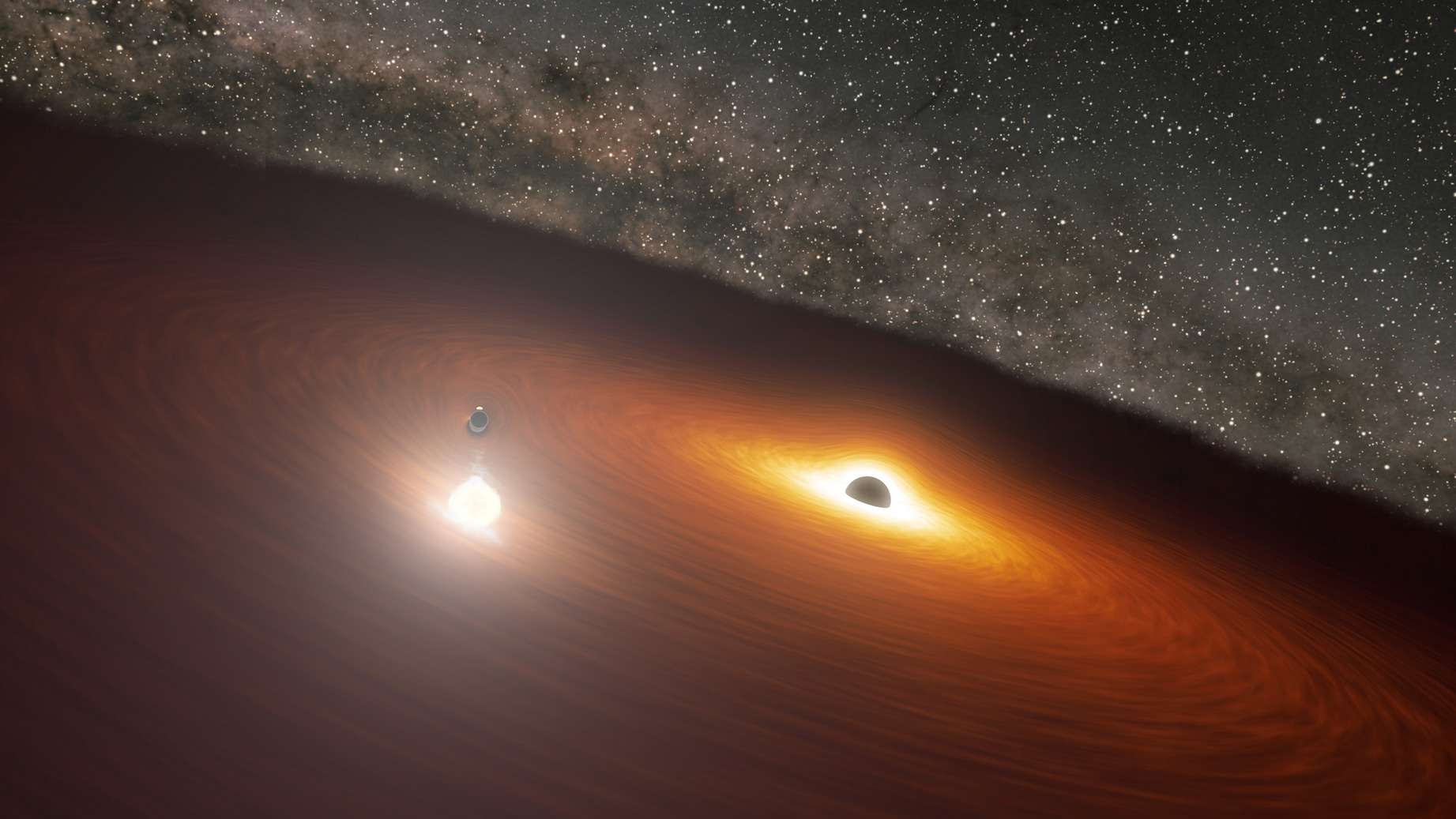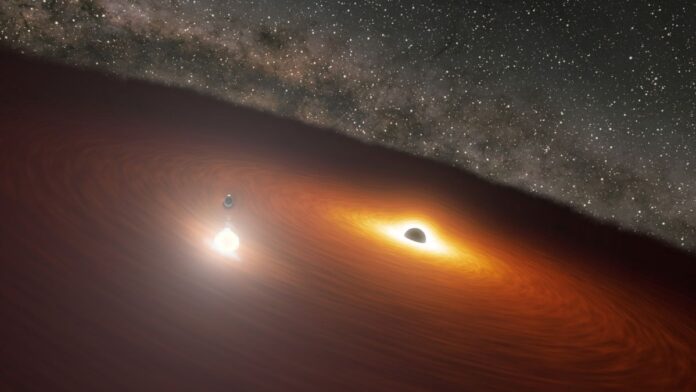Astronomers have confirmed the presence of a second supermassive black hole in the turbulent heart of a distant galaxy.
The scientists also found that both of these cosmic monsters are feeding on gas and dust and that one has a peculiar oblong orbit that sends it plunging through a massive disk of red-hot dust and gas around its companion.
The second black hole behemoth found at the center of OJ 287, a galaxy located around 5 billion light-years away, has a mass of about 150 million suns. As intimidating as that is, the black hole it orbits is even more massive — equivalent to over 18 billion suns — and is greedily feeding on surrounding gas and dust in the form of an accretion disk.
Related: Feeding black hole blows ‘cosmic bubbles’ amid high-energy burps
Matter from this violent cosmic whirlpool that doesn’t fall to the surface of this supermassive black hole is channeled to its poles and is blasted out as powerful jets in a process that makes the galactic center shine brightly as a type of active galactic nucleus (AGN) called a quasar.
It was in this accretion disk that astronomers spotted signals of a second orbiting supermassive black hole. As that second black hole plunges through the accretion disk surrounding the main black hole, it triggers a series of flares.
These flares arise as the diving black hole heats the disk of material and causes it to “burp” out hot gas as expanding bubbles. The gas bubbles cool over a period of months, radiating light and emitting flashes that last around two weeks and are brighter than the combined light from a trillion stars or the entire light output from the Milky Way.
The new research accurately predicts the timing of the second black hole’s dives through the accretion disk, thus allowing astronomers to model both the flattened, oblong orbit of the second black hole and the timing of the accretion-disk flares it creates.
Hidden monster
OJ 287, which lies in the direction of the constellation Cancer, was discovered over 120 years ago in photographic plates that showed the quasar at its heart.
Though this quasar had been well studied, the black holes had appeared as a single merged dot in observations. It was only after determining two different types of signals that astronomers were able to speculate about the true binary nature of this AGN.
Around four decades ago, Aimo Sillanpää, an astronomer at the University of Turku in Finland and co-author of the new research, and his colleagues noticed a prominent pattern in the emission of OJ 287. They identified two cycles — one of about 12 years and one of about 55 years. This indicated two black holes swirling around each other, with the shorter cycle being the orbital period and the longer cycle arising from the orientation of this orbit shifting over time.
“The two black holes are so close to each other in the sky that one cannot see them separately; they merge to a single point in our telescopes,” Mauri Valtonen, an astronomer at the University of Turku in Finland who led the research, said in a statement. “Only if we see clearly separate signals from each black hole can we say that we have actually ‘seen’ them both.”
During an observational campaign in 2021/2022 conducted by a number of telescopes, astronomers were finally able to obtain direct evidence of the secondary black hole diving through the accretion disk and gather signals from that second cosmic titan.
“The period in 2021/2022 had a special significance in the study of OJ 287,” Valtonen said. “Earlier, it had been predicted that during this period, the secondary black hole would plunge through the accretion disk of its more massive companion. This plunging was expected to produce a very blue flash right after the impact, and it was indeed observed, within days of the predicted time.”

Explosive surprises
Despite matching prior predictions, the new observations still delivered some surprises. For example, the astronomers spotted types of flares that hadn’t been detected before, including a massive flare that was 100 times brighter than an entire galaxy and lasted just a day.
“According to the estimates, the flare occurred shortly after the smaller black hole had received a massive dose of new gas to swallow during its plunge,” Valtonen said. “It is the swallowing process that leads to the sudden brightening of OJ287. It is thought that this process has empowered the jet, which shoots out from the smaller black hole of OJ 287. An event like this was predicted ten years ago but has not been confirmed until now.”
When the secondary black hole dove through the accretion disk of its larger partner, it also created a powerful burst of gamma-rays — the largest seen from this system in six years — that was observed by the Fermi Gamma-ray Space Telescope. The gamma-ray blast was created by a jet of material from the secondary black hole hitting the gas in the main accretion disk. This was confirmed when the scientists looked back through archival data and saw a similar gamma-ray burst in 2013 — the last time the smaller black hole dropped through the accretion disk.
“So what about the one-day burst? Why have we not seen it before?” Valtonen said. “It turns out that we have simply just had bad luck. Nobody observed OJ287 exactly on those nights when it did its one-night stunt.”
While astronomers will continue to study the black hole binary at the heart of OJ 287 in the electromagnetic spectrum with an array of telescopes, the confirmation of a binary black hole pairing makes the system an ideal candidate for the detection of gravitational waves, tiny ripples in space-time that are caused when massive objects accelerate and orbit each other. Gravitational waves carry angular momentum away from binary systems and thus cause their occupants to spiral together. This means that eventually, the two black holes of OJ 287 will merge to create an even more monstrous supermassive black hole.
The team’s research is published in the journal Monthly Notices of the Royal Astronomical Society.

